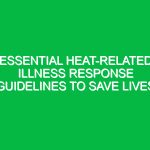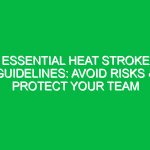“`html
Essential Heat Stress Guidelines: Avoid Risks and Stay Safe This Summer
Good morning team,
Today, we’re going to discuss an incredibly important topic as we move into the hotter months: Essential Heat Stress Guidelines: Avoid Risks and Stay Safe This Summer. As temperatures rise, so do the risks associated with heat stress in the workplace. Understanding how to recognize the symptoms of heat-related illnesses and implementing Safety Measures can make a significant difference in protecting your health and the health of your coworkers.
Understanding Heat Stress
Heat stress occurs when the body cannot properly cool itself down, leading to a rise in body temperature. This can be particularly dangerous in environments where employees are exposed to high temperatures, humidity, or strenuous physical activities. Heat stress can lead to serious health issues such as heat exhaustion, heat stroke, and even death.
Many employees might believe that heat stress only affects those working outdoors, but it can also occur in indoor environments, such as factories or warehouses, where heat and humidity levels can become dangerously high. Understanding heat stress and its implications is crucial for everyone’s Safety.
Key Hazards, Risks, and Safety Considerations
There are several Hazards and risks associated with heat stress that all employees should be aware of:
- High Temperatures: Working in environments with elevated temperatures can lead to heat-related illnesses.
- Humidity: High humidity can impair the body’s ability to cool itself through sweat evaporation.
- Physical Exertion: Engaging in heavy physical activities increases the risk of heat stress.
- Inadequate Hydration: Not drinking enough fluids can lead to dehydration, exacerbating heat stress.
Ignoring safety protocols related to heat stress can lead to serious consequences. For instance, heat exhaustion can cause dizziness, confusion, and fainting, while heat stroke is a medical emergency that can result in permanent disability or death. It is essential to recognize the symptoms and act promptly.
Best Practices, Procedures, & Actionable Advice
To prevent heat stress, here are some effective Best Practices and Procedures:
1. Stay Hydrated
Drink plenty of water before, during, and after work. Aim for at least 8 ounces every 20 minutes if working in hot conditions. Avoid drinks with caffeine or alcohol as they can lead to dehydration.
2. Take Regular Breaks
Implement a schedule for regular breaks in a cool or shaded area. Use the buddy system to monitor each other for heat stress symptoms.
3. Wear Appropriate Clothing
Choose light-colored, loose-fitting clothing that allows sweat to evaporate. Consider wearing moisture-wicking fabrics designed for hot environments.
4. Acclimatization
Gradually increase workloads and exposure to high temperatures over a week for new employees or those returning after time off. This helps the body adapt to the heat.
5. Monitor Weather Conditions
Stay informed about temperature and humidity levels. Use tools like the Wet Bulb Globe Temperature (WBGT) index to assess heat stress risk.
6. Recognize Symptoms of Heat Stress
Be aware of the signs of heat stress, including:
- Heavy sweating
- Weakness or fatigue
- Dizziness or fainting
- Nausea or vomiting
- Headaches
7. Emergency Action Plan
Have an emergency response plan in place. If someone shows signs of heat stroke (high body temperature, confusion, or unconsciousness), call 911 immediately and begin cooling measures such as moving them to a cooler Environment and applying cool water.
Regulations, Standards, and Compliance
Various safety Standards aim to protect employees from heat stress. The Occupational Safety and Health Administration (OSHA) has guidelines in place for working in hot environments. Compliance with these Regulations is not only essential for legal reasons but also to ensure the health and safety of all employees.
By adhering to heat stress guidelines, companies can reduce the risk of heat-related incidents and maintain a safer work environment. It is crucial for everyone to understand their role in these Safety Measures.
Employee Engagement & Discussion
As we wrap up, I want to encourage you to think about your experiences with heat stress. Have you ever felt the Effects of working in high temperatures? What safety challenges have you encountered related to this? Let’s take a moment to discuss how we can improve our safety practices and keep each other accountable.
Conclusion & Key Takeaways
In summary, recognizing heat stress and implementing essential guidelines is critical for a safe work environment during the summer months. Remember to:
- Stay hydrated
- Take regular breaks
- Wear appropriate clothing
- Monitor symptoms and act quickly in emergencies
Thank you for your attention today. Let’s prioritize safety and ensure that we all enjoy a safe and healthy summer at work!
“`


